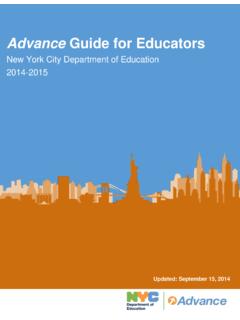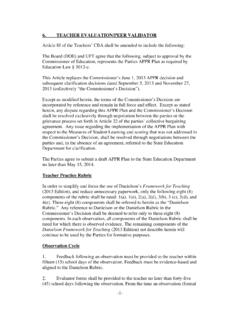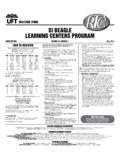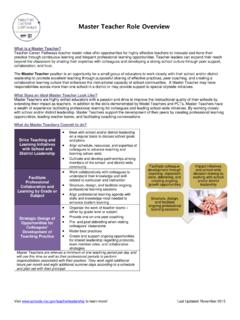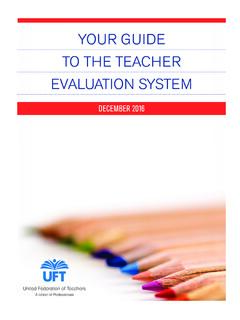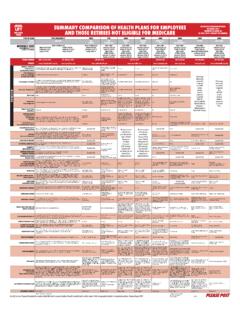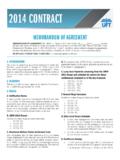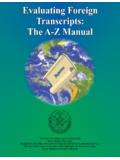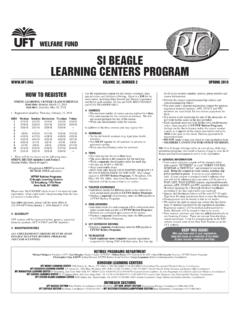Transcription of An end-of-year guide to the new teacher …
1 Summing it up: An end-of-year guide to thenew teacher evaluation & development SYSTEMA QUICK-START guide FROM THE UNITED FEDERATION OF TEACHERSTHIS QUICK-START guide BELONGS TO:United Federation of TeachersA Union of Professionals2013-2014 school yearIntroduction SUMMING IT UP APRIL 2014 Winding down the year: The last 90 daysThis is the first and we hope the last guide to ending a school year under this particu-lar teacher evaluation and development system. The UFT is currently negotiating with the city about the evaluation now, as we approach the end of the 2013-14 school year, we hope this guide will help you navigate the evaluation process over the next few begin, a quick review of some of the terms you have heard throughout this year and will see again in this guide : artifacts : These are items that you as a teacher gather over the course of the school year to illustrate and provide tangible evidence of your best teaching and component score: Components are the 22 specific categories outlined in the four domains of Danielson s Framework for Teaching (2013 Revised Edition).
2 Each component is scored on a range of 1 to 4 based on observations and submitted teacher artifacts . Domains: The components of the Danielson Framework are grouped into four domains: Domain 1 - planning and preparation; Domain 2 - the classroom environment; Domain 3 - instruction; Domain 4 - professional responsibilities. Evaluator (supervisor): Your evaluator or supervisor can be your principal, an assistant principal, district superintendent or assistant superintendent who has received training to observe and evaluate teachers in accordance with state Education Law 3012-c. Final composite APPR rating or APPR composite score: The final score you receive will be based on the composite scores of the three parts of the Annual Professional Performance Review (APPR): the state measure of student learning; the local measure of student learning; and other measures of teacher effectiveness including observations.
3 Group measures: Also called grade-level or schoolwide measures, these are any measures that cross classrooms. They are based on all the students in a particular grade and subject who are taking the same assessments, even if they take them with different teachers. HEDI: This is an abbreviation for the four rating categories highly effective, effective, developing, and ineffective established by the state education 11: Last day to submit teacher artifacts , except at your summative conferenceJune 6: Last day for observationsApril 25: First day for summative conferencesJune 20: Last day for summative conferencesSUMMING IT UP APRIL 2014 1 Observations and other measures of teacher effectiveness Last day to submit artifacts is April 11 or at summative conference: artifacts give you an opportunity to demonstrate your work in a way that might not be captured through an observation. For example, Danielson component 4C discusses communicating with families.
4 If you send home a parent newsletter, you might consider submitting those newslet-ters as an artifact. You choose up to eight artifacts for the year. Visit for a partial list of possible artifacts . artifacts are about best foot forward. Think about how you can document for your school leaders your best work this year. You could place a brief explanation page about your artifacts in your artifact folder but it is NOT required. Find out the process for handing in artifacts in your school. Be sure to follow it so that your artifacts are understood to be ARTI-FACTS, not some unrelated administrative requirement. Send a follow-up email after submission asking for feedback. If there are any Danielson components for which your evaluator has not collected evi-dence, he or she must ask you for additional artifacts or conduct additional observations prior to your summative conference. If you don t submit these additional artifacts , you may be given an ineffective rating for those components.
5 Summative end-of-year conferences will run from April 25 to June 20:This is a mandatory, one-on-one conference with your principal or evaluator that should occur during the school day. It is an opportunity to discuss the year including your classroom observations and any artifacts you submitted. It is also an opportunity to review your professional goals for the year, how you met them and the work you see ahead. Be prepared to advocate for your strengths. Be ready to refer to your observation reports and your responses. Be armed with any remaining artifacts that you have chosen to submit. Last day for observations is June 6: It is entirely the evaluator s responsibility to conduct the required number of observations, but if you have not had the required number of observations by now prior to the summa-tive conference you may want to document that in writing and give it to your chapter leader both as an email and a hard Professional RecordsHere are some documents you could take to your summative conference: A copy of your teacher evaluation option form and the videotape form from your initial planning conference.
6 Copies of all observation reports; copies of all feedback and your responses to feed-back, if applicable; and any other documen-tation or notes you have on your observa-tions and feedback. Documentation or notes on any and all requests you have made for assistance, ma-terials or professional development and on the responses to those requests. Copies of all artifacts submitted and any feedback and scoring on is also important that you keep records in case down the road you need to appeal your year-end rating. A more complete list of records to keep is at SUMMING IT UP APRIL 2014 Your rating on observations and other measures of effectivenessNo later than 10 days after your summative conference, you should receive your rating for the portion of your evaluation on observations and other measures of teacher effectiveness. Each Dan-ielson component in all four domains is rated, and then these smaller individual ratings are combined through a complex formula into a single number be-tween 1 and 4 that will fall into a category for highly effective, effective, developing or ineffective (known as HEDI categories).
7 (After the rating on the 1-to-4 scale is calculated, it is converted to a 60-point scale, representing 60 percent of your overall year-end rating. You can find the conversion chart at )Rating categories for observations and other measures of effectiveness:The Danielson Framework for Teaching, with the 22 components to be used in the teacher evaluation and development process: Highly - - - - 1: Planning and PreparationDomain 2: Classroom Environment 1a Demonstrating Knowledge of Content and Pedagogy 1b Demonstrating Knowledge of Students 1c Setting Instructional Outcomes 1d Demonstrating Knowledge of Resources 1e Designing Coherent Instruction 1f Designing Student Assessments 2a Creating an Environment of Respect and Rapport 2b Establishing a Culture for Learning 2c Managing Classroom Procedures 2d Managing Student Behavior 2e Organizing Physical SpaceDomain 4: Professional ResponsibilitiesDomain 3.
8 Instruction 4a Reflecting on Teaching 4b Maintaining Accurate Records 4c Communicating with Families 4d Participating in the Professional Community 4e Growing and Developing Professionally 4f Demonstrating Professionalism 3a Communicating With Students 3b Using Questioning and Discussion Techniques 3c Engaging Students in Learning 3d Using Assessment in Instruction 3e Demonstrating Flexibility and ResponsivenessSUMMING IT UP APRIL 2014 3 Measures of student learning (MOSL)In addition to observations and other measures of teacher effectiveness, your evaluation will come from measures of student learning based on state and local assessments that your students take and possibly on group measures. These measures are always based on student growth in other words, they measure where each stu-dent ended compared to where the student began. To be as fair as possible, the measures compare each student s growth to the growth of similar deciding whether students are similar, some of the factors that may be considered are the students academic history, special education status, ELL status and whether they are economically will assessment results figure into your evaluation?
9 The state has set standards for student growth. If your students growth is average compared to similar students, then the state standard shows you as an effective teacher . Ultimately, teachers will be awarded points based upon the extent to which students have met these standards, how well they did compared to stu-dents just like it up To calculate your overall rating, each of your ratings on the state and local measures of student learning will be converted to a 20-point scale and these points will be added to those you re-ceived on the 60-point scale for other measures of teacher effectiveness. Add-ing up these points will give you your total points on a 100-point scale. Rating Standards Highly EffectiveResults are well above average for similar are average for similar studentsDevelopingResults are below average for similar studentsIneffectiveResults are well below average for similar studentsFinal RatingState measures of student learning 20pts Local measures of student learning 20ptsOther measures of teacher effectiveness 60ptsOverall composite scoreHIGHLY EFFECTIVE18-2018-2055-6091-100 EFFECTIVE15-1715-1745-5475-90 DEVELOPING13-1413-1439-4465-74 INEFFECTIVE 0-12 0-12 0-38 0-644 SUMMING IT UP APRIL 2014 For more information, go to your chapter leader or district representative with any questions or concerns.
10 If you are concerned about how the evaluation system is being implemented at your school, talk to your chapter leader or district representative about filing an APPR complaint form. If you are concerned about the rating you may receive for the 2013-14 school year, talk to your chap-ter leader or district representative about filing an APPR end-of-the-year questionnaire. Your district representative can be reached through the union s borough offices:Bronx 718-379-6200 Hours: Monday - Friday: 10 - 7 Brooklyn 718-852-4900 Hours: Monday, Wednesday, Thursday, Friday: 10 - 6 Tuesday: 10 - 7 Manhattan 212-598-6800 Hours: Monday - Thursday: 10 - 7 Friday: 10 - 6 Queens 718-275-4400 Hours: Monday, Tuesday, Wednesday, Friday: 10 - 6 Thursday: 10 - 7 Staten Island 718-605-1400 Hours: Monday, Wednesday, Thursday, Friday: 10 - 6 Tuesday: 10 - 7 IT UP APRIL 2014 5 end-of-year TIMELINE DATES AND ITEMSAPRMAROCTMAYJUNJULYSEPT2014 NYC performance assessments and 3rd-party assessments.
